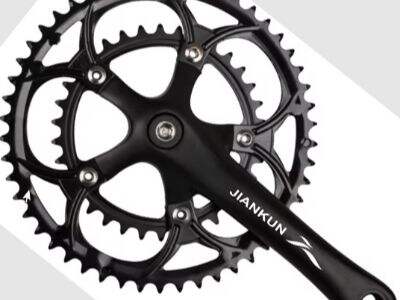Chainring materials determine the weight of the bike component and therefore influence its strength-to-weight characteristics. Various properties of chainring materials help individuals reach the best performance results on the road or trail. For instance, the low weight of a material affects the convenience and speed of bike riding.
There are several critical factors that determine performance and durability:
Materials significantly affect the performance and durability of chainrings. In particular, aluminum is lightweight and, therefore, is selected by cyclists wishing to reduce the bike’s weight. However, aluminum may not be as durable as steel or carbon fiber, and the cyclist risks the deformation of the ring with frequent and intense training. Steel chainrings, for example, are extremely durable and can be used frequently, but they are heavier than aluminum and carbon fiber. Carbon fiber, in turn, combines the advantages of lightweight aluminum and durability steel, which allows the cyclist to use a specific shape longer. Thus, cyclists can weigh their priorities based on the results of how different materials affect the performance and durability of the use of a track chainring.
There are several key benefits to using lightweight chainring materials that can help to enhance a cyclist’s performance on the bike. Firstly, the reduced weight of the material can have positive effects on overall bike performance, such as increased speed and agility on the road or trail. Lightweight chainrings also help provide a more responsive and efficient pedal stroke, meaning that cyclists can exert less energy while riding. Lastly, the lightweight material can also reduce rider fatigue, especially on longer rides. Aluminum or carbon fiber models offer these benefits, so many cyclists choose them to elevate their performance. The material of the chainring plays an essential role in cycling performance. The single chainring is a part of a bike’s drivetrain that transfers power from cyclists’ legs to the wheels.
Different materials differ in their strength and weight.
The use of aluminum is common since it is lightweight but strong. Light but strong aluminum is an excellent material for riders who require a low weight but do not want to lose the quality of their equipment. However, aluminum chainrings can wear out more quickly and require more frequent replacements. Steel is another chainring material option. Steel is heavy and very strong. Although it supplies good durability, it can bend, show irregular shape, and malfunction under heavy load.
Titanium is a high-end material that is well-known for its high strength-to-weight ratio. As a stronger material than aluminum and lighter than steel, titanium is always the best choice for high-performance riders. In addition to its high strength and resistance to corrosion, titanium chainrings are more expensive. Carbon fiber is a lightweight and rigid material used in various cycling applications. Carbon fiber has high strength-to-weight ratio features, making it the best material for professional cyclists and competitive cycling. Carbon fiber chainrings have yet to be used on a bike. Initially, they are all expensive, but they have the performance of a lifetime.
Selecting a chainring Material for your Wholesale Business
Most customers prefer aluminum chainrings because it is an all-around material that suits everyone. It is worth purchasing since it is impossible for most people to lose easily. Customers who buy steel chainrings are looking for a cheaper and weight-effective alternative. Titanium and carbon fiber materials are ideal for customers looking for the best performance. Customers always visit the manufacturer with quality titanium materials to buy at less cost. Retailers will not hesitate to appeal to carbon fiber material buyers due to its cost. Both titanium and carbon chainrings are ideal for your customers depending on the material costs. retailers with carbon and titanium chainrings will always have first-time buyers and repeat customers. Covering chainring materials such as titanium and carbon materials helps a retailer to attract a wide audience. Satisfy your customers by offering the perfect material that will cover all their needs.
Unethical Principles of the Strength-to-Weight Chainring Ratio
The other factor to consider chainring materials’ strength-to-weight ratio has a huge influence on a bike’s performance. This ratio is essentially a measure of a material’s resistance to forces relative to the amount of material present. It influences the efficiency and speed of the bike on the road. Aluminum chainrings have the best weight ratio and strength. The two factors are well balanced allow for quick changes on the road, but a rider may need to replace them more often compared to steel or titanium chainrings. Steel chainrings have the highest weight-to-strength ratio. They may make a bike heavier but are the most durable materials available. Titanium chainrings have the best weight strength ratio compared to the two materials discussed above. Carbon fiber chainrings are the most effective chainring materials with the best weight strength ratio. They are light and strong enough to resist the impacts of long rides and other stiff competition conditions. A chainring’s strength-to-weight ratio is crucial for a rider in determining the right component to use while cruising.

